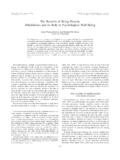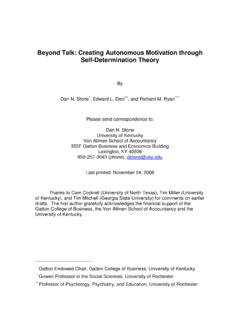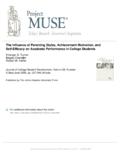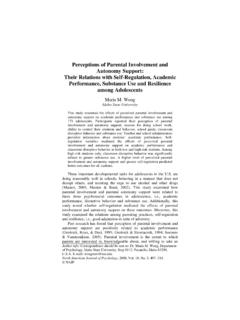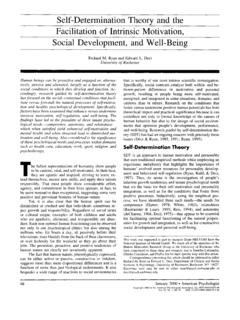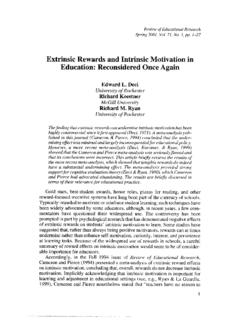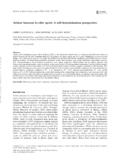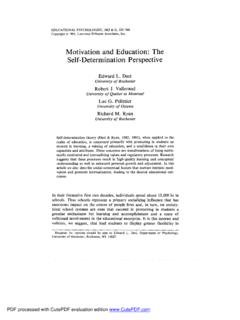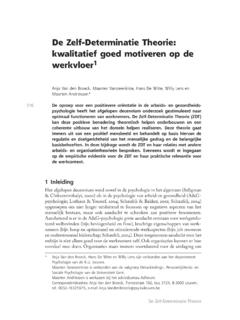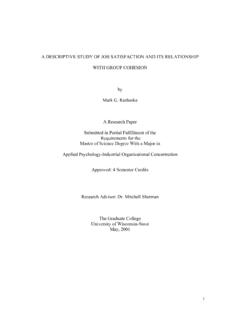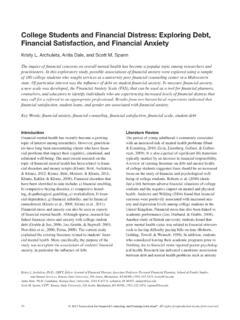Transcription of Measuring basic needs satisfaction: Evaluating previous ...
1 Contemporary Educational Psychology 35 (2010) 280 296. Contents lists available at ScienceDirect Contemporary Educational Psychology journal homepage: Measuring basic needs satisfaction : Evaluating previous research and conducting new psychometric evaluations of the basic needs satisfaction in General Scale Mary M. Johnston *, Sara J. Finney Center for Assessment and Research Studies, MSC 6806, Department of Graduate Psychology, James Madison University, Harrisonburg, VA 22807, United States a r t i c l e i n f o a b s t r a c t Article history: Self-Determination Theory speci es the existence of three basic psychological needs : autonomy, compe- Available online 10 April 2010 tence, and relatedness.
2 The current set of studies (a) provides a narrative review of past research on the basic needs satisfaction in General Scale, (b) examines its dimensionality which has been assumed but Keywords: not empirically studied, and (c) gathers external validity evidence. Con rmatory factor analysis was used basic needs satisfaction to test the existence of a one- and a three-factor solution; neither model t the data. After patterns of Self-Determination Theory mis t were examined across three independent samples, a reduced, 16-item three-factor model with a Construct validity negative-worded method effect was championed.
3 External validity evidence, collected by examining the differential relationships between the three needs and measures of well-being and worry, supported the distinctiveness of the three needs . Although the results are promising, future research is needed to examine the generalizability of the psychometric properties of the modi ed scale. 2010 Elsevier Inc. All rights reserved. 1. Introduction basic needs according to Self-Determination Theory During the past century the theory that humans have basic SDT postulates the existence of three basic needs : autonomy, needs has been developed and expanded by several different theo- competence, and Autonomy refers to the need to feel rists.
4 For example, some researchers have theorized needs are in- that one's behavior and resulting outcomes are self-determined, or nate in humans ( , Deci & Ryan, 2000; Hull, 1943), whereas self-caused, as opposed to being in uenced or controlled by out- other researchers have theorized needs are learned over time side forces (deCharms, 1968; Deci & Ryan, 1985, 2000). Compe- ( , McClelland, 1965; Murray, 1938). Furthermore, researchers tence refers to the need to feel effective and capable of have differed in regards to what constitutes a need. Some research- performing tasks at varying levels of dif culty (Harter, 1978; Ryan ers have proposed needs are psychological in nature ( , domi- & Deci, 2002; White, 1959).)
5 Relatedness refers to the need to feel nance; Murray, 1938), whereas other researchers have proposed connected to, supported by, or cared for by other people (Baumei- needs are physiological in nature ( , food; Hull, 1943). In con- ster & Leary, 1995; Ryan & Deci, 2002). SDT stipulates all three trast, some theorists have proposed needs are a combination of needs must be ful lled for psychological well-being to occur (Deci the both ( , Maslow, 1970). Self-Determination Theory (SDT) de- & Ryan, 2000). That is, if only one or two of the three needs are nes needs as innate, psychological , and essential for well-being ful lled psychological health will suffer (Deci & Ryan, 2000; Ryan, (Deci & Ryan, 2000).
6 1995). * Corresponding author. E-mail address: ( Johnston). 1. Although SDT currently postulates the existence of three basic psychological needs , it is important to note there may exist more. However, autonomy, competence, and relatedness are currently the only three needs that adhere to the criterion of needs as de ned by SDT ( , required for psychological well-being and growth; Ryan & Deci, 2000c). For instance, several needs previously hypothesized by other theories ( , achievement and self-esteem) are not considered needs by SDT because they do not directly impact psychological well-being; they are considered desires (Baard, Deci, & Ryan, 2004; Ryan & Deci, 2000c).
7 Furthermore, these desires are often detrimental or entail negative consequences to an individual rather than increase well-being (Ryan & Brown, 2003). For more information regarding this discussion, please refer to Deci and Ryan (2000), Ryan and Deci (2000c) and Ryan and Brown (2003). 0361-476X/$ - see front matter 2010 Elsevier Inc. All rights reserved. Johnston, Finney / Contemporary Educational Psychology 35 (2010) 280 296 281. In addition to being important for psychological well-being, mation about the scale. Benson (1998) outlined three stages according to the sub-theories of SDT, Cognitive Evaluation Theory required to establish a strong program of construct validity: sub- (CET) and Organismic Integration Theory (OIT), needs satisfaction stantive, structural, and external (see also Benson & Hagtvet, is also crucial for psychological growth (Deci & Ryan, 2000; Ryan 1996).)
8 The rst stage (substantive) refers to the process of de ning & Deci, 2000a, 2002). According to CET, the ful llment of basic the theoretical and empirical domains of the construct of interest. needs (autonomy and competence in particular) has a direct, posi- Speci cally, the theoretical domain is representative of all informa- tive in uence on intrinsic motivation ( , performing an activity tion known about the construct; it is the scienti c theory sur- for inherent interests and pleasure; Deci & Ryan, 1985; Ryan & rounding the construct (Benson, 1998, p. 12). The empirical Deci, 2000a, 2002).
9 That is, feelings of being controlled by external domain is representative of all observed variables that are used forces or being ineffective regarding the task at hand will under- to represent the construct. Thus, the theoretical domain should mine levels of intrinsic motivation and will result in being con- be broadly de ned, whereas the empirical domain is more speci c trolled by external criteria, such as a pay check or a superior's in nature but a function of the theoretical domain. The second approval (Deci & Ryan, 1985, 2000; Ryan & Deci, 2000a). Moreover, stage (structural) involves examining the interrelationships be- according to OIT, psychological growth (becoming more autono- tween the observed variables ( , the items).)
10 Correlations, inter- mous in behaviors performed), aids in the creation of a uni ed nal consistency, and factor analysis are often assessed at this sense of self , or a person who successfully interacts with the social step. The third stage (external) involves examining if the construct environment and others (Ryan & Deci, 2002, p. 5). Speci cally, is related to external constructs in theoretically expected ways. growth occurs with the integration and internalization of ideas This is considered the most essential stage because it provides or behaviors formerly motivated by extrinsic forces, or the accep- information regarding the nomological network of the construct.
